| Article ID | Journal | Published Year | Pages | File Type |
|---|---|---|---|---|
| 2627467 | Physiotherapy | 2011 | 9 Pages |
AimsTo assess the sensitivity of selected outcome measures to any change resulting from treatment of adults with cystic fibrosis with physiotherapy musculoskeletal techniques, use the data for sample size calculations for future studies and assess the acceptability of the methods to potential participants.DesignPreliminary, prospective, single-blind, randomised controlled trial.SettingSpecialist cystic fibrosis centre.ParticipantsAdults recruited from a cystic fibrosis outpatient clinic.InterventionsThe control group received normal optimal physiotherapy care and the intervention group received weekly musculoskeletal treatment for 6 weeks in addition to normal optimal physiotherapy care.Outcome measuresRecorded at baseline, 3, 6 and 12 weeks. The outcome measures were posture (thoracic index), chest wall excursion, forced expiratory volume in 1 second (FEV1), visual analogue scale for pain, modified shuttle test and Cystic Fibrosis Quality of Life Questionnaire – Section One (physical functioning).Statistical analysisDescriptive statistics [using medians and interquartile ranges (IQRs)] and linear regression mixed model.ResultsFrom a total of 20 subjects, 10 were randomised to each group. Fifty percent of subjects were male, with a median age of 27 years (IQR 25 to 34), median FEV1 of 1.75 l (IQR 1.4 to 2.4) and median body mass index of 20.8 (IQR 20.0 to 23.5). Baseline differences between groups in thoracic index and modified shuttle test made any differences difficult to interpret, but the results for thoracic index and chest wall excursion at the third rib in the treatment group showed a trend towards improvement. The usefulness of FEV1, the visual analogue scale for pain and the Cystic Fibrosis Quality of Life Questionnaire as measures is unclear.ConclusionFurther musculoskeletal studies in people with cystic fibrosis should consider using thoracic index and a measure of lung function in addition to FEV1. The musculoskeletal techniques appear to be acceptable to people with cystic fibrosis, and do not seem to have associated adverse effects.
